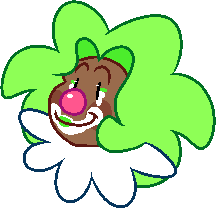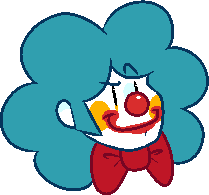Evolution of Clowns & Mimes
Clowns and mimes are incredibly similar to humans, but they aren't the same species or genus! They're both peaceful herbivores with unique traits which make them distinct from humans. The evolutionary history of clowns & mimes is hard to track. This is because clown skeletons are nearly identical to human structures. The only difference is the vestigial "funny bone," a thin 5-inch (2.54 cm) long bone that rests near the humerus, which is found only in clowns & mimes.
Clowns
It's estimated that clowns split off from humans about 300,000 years ago when they were isolated on a long-lost island devoid of predators. Protected from danger, they evolved bright colours to distinguish one another and impress mates. Their distinct red noses were also developed for sexual selection; brighter and rounder noses indicate a healthier clown. They decorated their living spaces with pretty objects they found, typically colourful shells, feathers, pearly rocks, and other bright things that washed up on the shore.
It's suspected that there were many clown species on the island. However, very few managed to make it to the mainland when the island sunk approximately 40,000 years ago. Reintroduced to predators, clowns began forming new societies and cooperating with humans. Whiteface clowns likely evolved their pale white skin around this time, adapting to the colder environment of the mainland.
To this day, clowns keep their fondness for colourful items and clothing. They also keep their cheery attitudes.
Mimes
It's unknown when mimes split off from humans, but the estimates are anywhere from 500,000 years ago to 350,000 years ago. They lived deep inside caves, leading them to evolve their distinctive pale white skin. Like clowns, they also developed markings but typically have fewer in more dull colours. Due to the echoes caused by deep caves, they adapted to become mostly mute to avoid attracting predators. They also lost some of their colour vision, becoming blue-yellow colourblind.
The evolution of the bizarre eye shape of true mimes (M. mimus) is still not understood. A leading theory is that the plus-shaped eyes were a dominant genetic mutation that spread due to vision being less critical in caves. However, even this seems somewhat unlikely.
Mimes still often live in cave environments, but their homes' destruction has led to mimes integrating within human society along with clowns. However, their integration was far more complex due to their whistles being difficult to distinguish to the human ear. Therefore to communicate with humans and clowns, they often resort to gestures.
Clown & Mime Species
Clowns and mimes are very varied. Here are some of the more common clowns and mime species you could expect to see:

Auguste Clown
Goofus augustus
The auguste clown is a peculiar species of clown. They have human-like skin tones, barring the markings usually found around their mouth and above the eyes. Auguste hair is typically straight but can also be wavy, curly, or other human hair types. The cheeks appear to be constantly blushed. Auguste clowns have the most prominent noses of any clown species. Auguste clowns tend to have naturally poor balance and an affinity toward shiny objects.
Traditional auguste clown accessories include baggy or oversized clothing, ties, vests, long socks, bowler hats, large collars, and suspenders.

Whiteface Clown
Goofus albiceps
The whiteface clown (also known as the traditional clown) is the figure most commonly associated with clowns. Their skin is completely white, and they have colourful markings around their eyes, cheeks, mouths, and foreheads. Whiteface clowns usually have curly or frizzy hair and brightly coloured noses. Unlike the auguste clown, they have naturally excellent balance. However, they share their affinity for shiny objects.
Traditional whiteface clown accessories include colourful ties, bowties, vests, long socks, large collars, suspenders, big clown boots, overalls, and buttons.

Pierrot Mime
Mimus tristis
The pierrot mime is a timid species of mime. They're prone to nervousness and bouts of pessimism. Like all mime species, they are blue-yellow colourblind and speak only through gestures and whistles. Their skin is completely white like the whiteface clown, and they usually have minor markings on their cheeks and lips.
Traditional pierrot mime accessories include suspenders, bowler hats, frilled collarets, and scarves (typically turquoise or red). The majority of their accessories are white or black.

True Mime
Mimus mimus
Not quite as shy or melancholic as the pierrot mime is the true mime. Their incredibly peculiar eye shape easily distinguishes them from other species. They are blue-yellow colourblind and speak only through gestures and whistles. Their skin is white, and they have few markings (markings are most often black and occasionally appear on the cheeks or the lips).
Traditional accessories include white and black striped shirts, suspenders, berets, or other hats.
Other notable species include:
Stilt Clown (Goofus giganteus): A species closely related to the whiteface clown, but known for growing to unusually high heights. They have incredibly long legs that allow them to reach up to 14 feet (4.3 metres)! Stilt clowns are usually born at a regular human height. However, they have a sudden growth spurt in their teenage years. This adaptation was likely for grazing on tall trees.
Jester (Goofus regalis): The jester is a species of clown which adapted itself to a medieval society. As human kingdoms expanded, clowns were often forced to migrate to find new lands to live in. Jesters, however, integrated themselves within human kingdoms. They were often employed to entertain rulers or nobles, though money has no meaning to a clown! Due to the changing social environment, jesters are much rarer today.
Scare Clown/Killer Clown (Mimogoofus venator): Despite common misconceptions, scare clowns aren't clowns at all! They evolved to mimic the peaceful and joyous clown to lure in prey. They're recognizable by slit pupils, pointed teeth, and a generally negative vibe. Luckily, there are very few instances of scare clowns attacking clowns, mimes, or humans! However, when well trained, they can make good companions.
Mixes: Members of the genus Goofus, Mimus, and even Mimogoofus can all mix and create hybrids! The vast majority of clowns, mimes, or combinations are hybrids.

